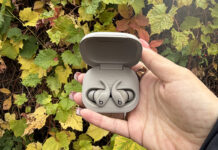 The latest version of House of Marley’s Positive Vibration XL ANC over-the-ear headphones look to be a winner, on paper at least. With a solid build made from quality, environmentally conscious materials, these mid-range pair from the Marley brand look to have plenty to recommend. Do they live up to the legacy of the musical icon that they celebrate? Read on to find out!
The latest version of House of Marley’s Positive Vibration XL ANC over-the-ear headphones look to be a winner, on paper at least. With a solid build made from quality, environmentally conscious materials, these mid-range pair from the Marley brand look to have plenty to recommend. Do they live up to the legacy of the musical icon that they celebrate? Read on to find out!
Positive Vibration XL specifications
- Model reviewed: EM-JH151-SB circumaural headphones
- 40mm drivers, memory foam ear chions, active noise cancellation (ANC)
- Includes USB Charging cable, male-to-male mini-jack aux cable, “stash” bag, stickers.
- Battery: 32 hours (26 hours with ANC), 2 hours to fully charge
- Bluetooth: Yes
- Built-in mic: Yes
Unboxing House of Marley’s Positive Vibration XL headphones
 The XL ANC are delivered in a handsome cardboard box that’s clearly designed to limit the usual amounts of waste generated with new products. The headphones themselves are wrapped in recycled materials, and even the usual plastic twist-ties wrapped around the cables are eschewed in favour of what look to be twisted recycled paper (perhaps, fittingly for the artist that gives the company its name, incorporating some hemp fibers).
The XL ANC are delivered in a handsome cardboard box that’s clearly designed to limit the usual amounts of waste generated with new products. The headphones themselves are wrapped in recycled materials, and even the usual plastic twist-ties wrapped around the cables are eschewed in favour of what look to be twisted recycled paper (perhaps, fittingly for the artist that gives the company its name, incorporating some hemp fibers).
The headphones themselves feel solid, weighing in at a not-insignificant 250g. Part of that is of course due to the built in amplification and generous 40mm drivers, but there are also wood accents (sourced sustainably) that give the cans a stylish look. The fabric on the headband is constructed with recycled materials, and the metal is predominantly recycled aluminum.
The package includes both USB C charging cable and an auxiliary headphone jack, a welcome addition that allows listeners to choose their own amplification and bypass the internal digital amplification. There are rubber buttons on the back of each earpad, with one side dedicated to noise-cancellation and monitor mode, and the other to volume up/down, power and various button combinations to pair with Bluetooth.
Positive Vibration XL headphones performance
 Pairing the headphones proved to be a bit more of a challenge than it likely should have been. A good test is usually to see how things behave without ever pulling out the startup guide, but it was soon clear that simply holding down the middle power button (a common way of pairing on other company’s models) wasn’t going to do the trick. Instead, you have to hold down the volume up and down buttons simultaneous for two seconds, which is much easier to do when they’re not on your head. Unfortunately, any audio feedback about pairing is then missing, and it took several times to reset the unit before I could successfully pair with my Android device.
Pairing the headphones proved to be a bit more of a challenge than it likely should have been. A good test is usually to see how things behave without ever pulling out the startup guide, but it was soon clear that simply holding down the middle power button (a common way of pairing on other company’s models) wasn’t going to do the trick. Instead, you have to hold down the volume up and down buttons simultaneous for two seconds, which is much easier to do when they’re not on your head. Unfortunately, any audio feedback about pairing is then missing, and it took several times to reset the unit before I could successfully pair with my Android device.
Once connected, the headphones did a decent enough job at maintaining their connection, though I did find that in as little as 10 feet away I’d occasionally get some breakup.
The active noise cancellation seemed reasonably well implemented, even if it immediately coloured the sound of the music that was playing. The second monitor button is presumably to be able to talk while leaving the set on your ears, but this felt entirely redundant given the ease in which these kind of headphones can simply be slung around your neck quickly.
Positive Vibration XL comfort
 Despite the generous memory foam earpads and soft material headband, I was surprised how quickly the Positive Vibrations became uncomfortable on my head. The tension of the headband can’t be adjusted, and the vinyl-like material definitely induced sweaty ears on a warm day. Perhaps using the same soft material on the pads would result in a less sticky situation, but the more durable material likely means that it’ll rip less often.
Despite the generous memory foam earpads and soft material headband, I was surprised how quickly the Positive Vibrations became uncomfortable on my head. The tension of the headband can’t be adjusted, and the vinyl-like material definitely induced sweaty ears on a warm day. Perhaps using the same soft material on the pads would result in a less sticky situation, but the more durable material likely means that it’ll rip less often.
Positive Vibration XL sound quality
Connected via Bluetooth the sound seemed to over emphasise the bass and high frequencies, making the mid-range more muted than desired. The result was a thumpy, brittle sound that didn’t feel satisfying. The volume was also relatively limited, so for older tracks that haven’t been compressed to compete with modern recordings suffered from overall thinness. Plugging in the minijack and bypassing the built-in amplification allowed the drivers to shine more fully, though even then there was an emphasis on both low and high frequencies that made it feel overly equalized compared to more accurate reproductions of the source.
It seemed a natural fit to test these headphones with a selection of tracks from Bob Marley himself, and the wide variety of his tracks proved to be an excellent way of determining both the pros and cons of this model. “Turn Your Lights Down Low” from Exodus had a nice mix of acoustic drums, electric piano and bright vocals that did not hold up well, particularly on Bluetooth. Bombastic tracks like the “Exodus” title track, or orchestrally dense recordings like “Is This Love” from Kaya, further exhibited a bloated bass feeling with shrill highs.
Switching to the aux cable, the headphones definitely came into their own, and acoustic tracks like “Redemption Song” from Uprising immediately benefited from the switch. Driven a bit harder the divide between mid-range and the upper and lower frequencies smoothed out, and it became clear that the issue was less to do with the robust driver construction and more with an anemic and poorly tuned digital amplifier driving them during Bluetooth playback.
I applaud House of Marley for including the headphone jack, as it means the lifetime of the model increases dramatically where long after the batteries cease charging they’ll still be a decent pair of headphones. Still, given the extra weight and complexity of the middling noise cancellation circuitry, combined with the paltry Bluetooth implementation, it seems that the real benefit might have been to switch to a pure wired model. Given the way the industry is being led by mobile phone manufacturers eschewing headphone jacks, the decision is understandable if no less frustrating for those of us that care specifically about the sound quality over such other conveniences.
Final take on House of Marley’s Positive Vibration XL headphones
While the Marley’s are a handsome set of ear candy, I found the lack of comfort after a short period of time, the over-colouration of the sound to goose the bass and high treble frequencies, and the under-powered Bluetooth implementation all contributing factors in not feeling the positive vibrations from these headphones. Plugged in via the aux cable showed off that beneath the digital makeover there’s a solid acoustic foundation, and for those that occasionally need the noise cancellation on a flight but would run a minijack for more critical listening may well find the best of both worlds here.
I again applaud House of Marley’s general environmental commitments, but I must point out that I’ve got headphones from 30+ years ago that I can keep listening to because of the simplicity of a wired connection. Built in obsolescence is contrary to any mission of environmentalism no matter how well the package is promoted, and the inclusion of the AUX jack at least shows their desire to provide performance for longer than the lifetime of the built-in batteries.
For those more interested in the convenience and needing some head-shaking bass these are definitely a model to consider, and they’ll deliver far more impact with their 40mm drivers than any in-ear model can contend with. For fans of electronic music in particular the lack of flat frequency response may in fact be a benefit. Yet for those of us that listen primarily to instrumental music, the Marley Positive Vibration XL ANC Model SL-151 simply doesn’t compete well with similarly priced offerings from some of its competitors.


